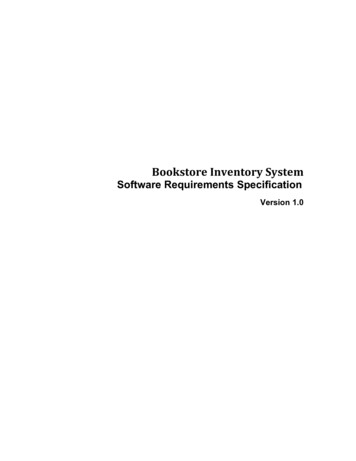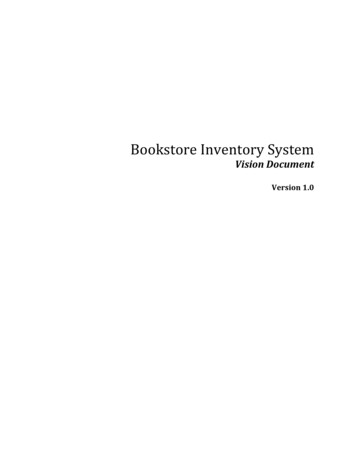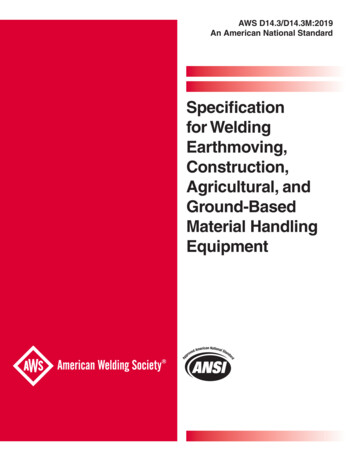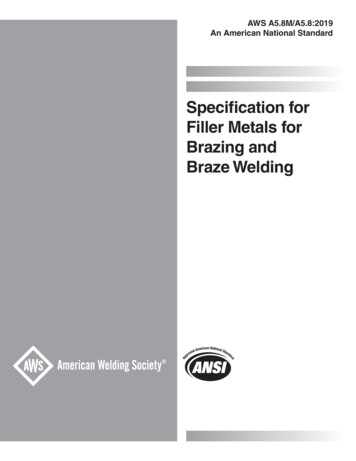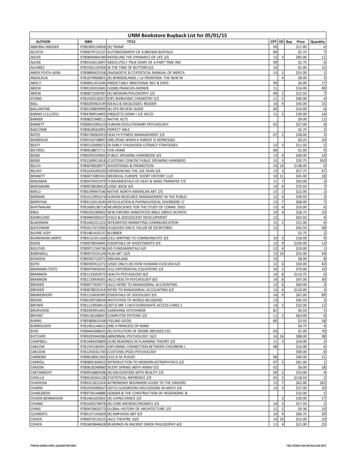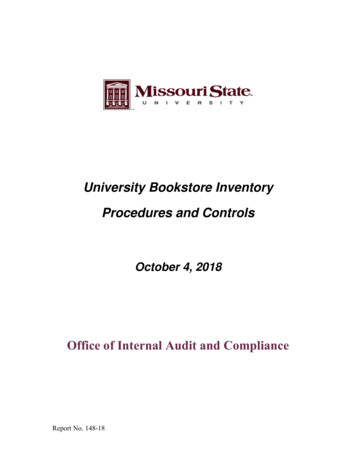
Transcription
University Bookstore InventoryProcedures and ControlsOctober 4, 2018Office of Internal Audit and ComplianceReport No. 148-18
DATE:October 4, 2018TO:Ray Presnell, Springfield Bookstore DirectorFROM:Donna Christian, Director of Internal Audit and ComplianceTami Reed, Senior Internal AuditorCC:Dr. Dee Siscoe, Vice President of Student AffairsRachael Dockery, General CounselClifton M. Smart III, University PresidentUNIVERSITY BOOKSTORE INVENTORY PROCEDURES AND CONTROLSBACKGROUNDOn June 29, 2018, Internal Audit observed and tested the annual physical inventory count at theMissouri State Bookstore. The Bookstore’s gross sales and year-end inventory balances for thelast six years is as follows:FYE June 30201820172016201520142013Sales (Retail) 13,261,236 14,648,897 15,767,532 15,279,233 15,571,547 15,776,401Inventory (Cost) 3,333,505 6,340,006 6,190,350 3,948,774 4,007,757 4,735,104As of June 30, 2018, the inventory balance of 3.3 million was considerably less than prior yearsbecause a majority of the Fall 2018 textbooks had not yet been received. Additionally, gross sales,as well as profits have dropped significantly during the last few years.OBJECTIVE AND SCOPEThe objective was to review the accuracy of inventory, assess the adequacy of internal controls,and review the financial management of store operations. The scope of the audit included, but wasnot limited to the fiscal year ended June 30, 2018.1
SUMMARYIncluded in this report are recommendations to: Periodically reconcile inventory within the Ratex point of sale system to the University’s Banneraccounting system.Ensure all adjustments posted to inventory balances are accurate. We identified 48,896 intextbooks that were returned to vendors in Fall 2017 but posted as an inventory write-off. As aresult, the bookstore paid for the textbooks and did not request credits from the vendor untilour audit.Segregate inventory duties to ensure the same person who orders, receives and returnsinventory can’t also write-off inventory.Improve the management of textbook inventory. We have made this recommendation in threeprevious audit reports. The annual loss on obsolete textbook inventory has grown from 142,836 to 676,597 since we initially made this recommendation in 2015.Establish written procedures for selecting, discarding, and writing off obsolete merchandise(excluding textbook inventory), and more closely manage electronic inventory to help reduceobsolete inventory. A similar recommendation was made in our 2017 audit report.Follow up on merchandise returns in a timely manner to ensure credit is received from thevendor. At June 30, 2018 there were 47 returns totaling approximately 64,000 that were overa year old but no credit memo had been received from the vendor. Little to no follow up hadbeen performed on these outstanding credits and as a result, 47,304 of the 64,000 waswritten off subsequent to our review.Develop a written business plan that moves the bookstore into the future under a new businessmodel. Textbook sales declined 1.6 million in the last two years and another 600,000 in thefirst two months of fiscal year 2019 for a total decline of 2.2 million. With textbooks salesaccounting for about 65 percent of total retail sales, and with more focus being placed on digital,open-access and low-cost content, a new business model is necessary to keep the storeprofitable. This recommendation was included in our 2017 audit report.Segregate duties within the Ratex point of sale system and discontinue allowing employees todisclose login credentials to other employees. These recommendations were included in our2017 audit report.Sincerely,Donna Christian, CPA, CGFMDirector of Internal Audit and ComplianceTami Reed, Senior Internal Auditor:Audit Fieldwork Completed: September 4, 20182
OBSERVATIONS, RECOMMENDATIONS AND MANAGEMENT RESPONSES1. PHYSICAL INVENTORY COUNT AND YEAR-END CALCULATIONSThe Bookstore inventory value at June 30, 2018 totaled 3,333,505.DepartmentValue (Cost)New TextbooksUsed TextbooksTotal Textbooks Accessories & FurnishingsCampus onGreekSouvenirsSchool and Art SuppliesTradebooksGrand 18 3,333,505A physical inventory count was performed on June 29, 2018 at the Bookstore. Internal Auditselected 180 inventory items (27.5% of the inventory cost value) to compare the physicalinventory count with the values in the Bookstore’s Point of Sale (POS) system, Ratex. Someminor audit differences were identified and adjustments were recorded in the Ratex system.The inventory balance was then reconciled to the University’s general ledger inventorybalances in Banner for financial statement presentation at June 30, 2018. We found that theyear-end inventory balance in Ratex was lower than the inventory balance in Banner by 147,090 valued at cost (or 189,734 retail value). This difference represents inventoryshrinkage throughout fiscal year 2018 and is 1.43% of retail sales. Historically, the NationalRetail Security Survey Final shrinkage percentage has been used as a benchmark to determineif the shrinkage realized by the bookstore is reasonable. The NRSSF reported the nationalshrinkage average was 1.33% of retail sales for 2017. The bookstore’s year-end shrinkage of1.43% is reasonably close to the national average.Periodic reconciliations should be performed to evaluate differences between inventorybalance in the Ratex POS system and the University’s Banner accounting system. The lastreconciliation prepared was in January 2018.RecommendationPerform periodic reconciliations of inventory costs to monitor any differences between theRatex POS system balances and the University’s Banner accounting system balances.3
Management ResponseThe July and August 2018 reconciliations have now been completed and forwarded to theOffice of Internal Audit and Compliance. The Business Manager is now dedicating time duringthe second week of each month to compile a reconciliation report. Reports are completed bythe 20th of each month.2. Inventory AdjustmentsWith the recent implementation of the Ratex POS system, changes in inventory can bemonitored regularly. As Bookstore personnel perform periodic physical inventory counts duringthe year, the inventory balances are adjusted and inventory shrinkage (write-off) is recorded inthe Ratex POS system throughout the year. Our review of these adjustments noted thefollowing:A. Some adjustments posted to reduce inventory balances are not accurate. During the yearended June 30, 2018 total inventory shrinkage recorded in Ratex for all departments was 195,986. Of this amount, the inventory shrinkage for new, used and digital textbooks,totaled 167,388 (85% of the 195,986). Our review of the entries that made up the 167,388 noted three large adjustments totaling 48,896 to reduce inventory for missingbooks. Our audit work revealed that these books were not missing, but had been returnedto the vendor and the entry should have been recorded as a return of merchandise insteadof an inventory write-off or shrinkage. Because of this incorrect entry, Bookstore personnelhad not followed up with the publisher to request a refund of the 48,896 since the bookswere returned in Fall 2017. After our review, Bookstore personnel contacted the vendor inJuly 2018 and requested a credit memo for 48,896 to apply toward future orders.Additionally, the inventory shrinkage was reduced to the 147,090 ( 195,986- 48,896)noted in Oberservation No. 1 above.B. Duties are not adequately segregated with respect to the employees who post inventoryadjustments to the Ratex POS system. Each department manager/buyer posts entries toreduce inventory balances (write-off, returns) within their own departments without anydocumented oversight. As a result, department managers/buyers who order, receive,return and manage inventory, also have access to increase or decrease inventory balancesin the Ratex POS system. To properly segregate duties, someone other than thedepartment manager/buyer should post accounting entries to adjust inventory balances. Ifproper segregation of duties cannot be achieved because of the lack of available staff, theDirector should implement a documented supervisory review of all adjustments toinventory.RecommendationsA. Ensure adjustments posted to inventory balances are accurate and follow up to ensure theBookstore receives credit for the 48,896 in returned textbooks.B. Adequately segregate duties by ensuring someone other than the departmentmanager/buyer posts accounting entries to adjust inventory balances. If proper segregationof duties cannot be achieved, a documented supervisory review should be performed.Management ResponseA. We recently received a credit of 22,100 of the 48,896. Employees in the CourseMaterials Department are working with the vendor to secure a credit for the balance.4
B. Management has developed a new policy requiring all inventory adjustments to bereviewed by the Bookstore Director and verified with the management team during the firstmeeting of each month. Department managers must be prepared to explain significantadjustments and provide documentation if necessary.3. OBSOLETE INVENTORYA. Textbook inventory management procedures for dead or obsolete textbooks continues tobe a systemic problem for bookstore management. Even after highlighting this concern inthe three prior audit reports, there continues to be an increasing need to establish andimplement policies and procedures to properly monitor and manage obsolete textbooks.Dead or obsolete textbooks are textbooks that have not been adopted for use by a class.The obsolete textbook balances, as well as losses, has continued to increase for the pastfour years as follows:FiscalYearEnd2015201620172018Cost of 142Value Receivedfor 2,836)(183,508)(88,854)(246,955)Cost of ObsoleteTextbooks in YearEnd Inventory******369,000477,380*** - information not readily available from old POS system (Booklog)As shown in the chart above, the Bookstore lost 246,955 on the sale of obsolete textbooksduring fiscal year 2018, but also still had obsolete textbooks in inventory costing 477,380that have not been sold. Some of these textbooks have not been adopted for a class since2017. Based upon the value received for the obsolete textbooks sold in 2018, it is unlikelythat the bookstore would receive more than an estimated 47,738 (10% value) for thesebooks costing 477,380. As a result, the bookstore is likely to incur an additional loss of 429,642 ( 477,380 - 47,738). Also, these obsolete textbooks make up approximately 20percent of the total cost of all new and used textbooks of 2,330,739. To ensure theUniversity’s financial statements are fairly stated, at the recommendation of Internal Audit,an adjustment was made to the textbook inventory balance and a reserve was establishedfor 429,642 to recognize the additional estimated loss.The total estimated loss on obsolete textbooks for fiscal year 2018 is 676,597 ( 246,955 429,642).Improving inventory management for textbooks could have avoided this significant loss.Excessive obsolete textbook inventory can stem from ineffective sales forecasting, poorplanning or using an outdated business model (see Observation No. 5 below). Bookstoremanagement should take steps immediately to: Review textbook ordering procedures to determine the optimal number of textbooks toorder for each class and establish ways to improve the ordering process to preventover ordering.Monitor textbook inventory closely to quickly identify excesses.Develop a plan to return or sell excess textbooks quickly to obtain maximum value.(Some publishers will allow for the return of textbooks for full or partial credit within aspecific window of time.)We initially brought this issue to management’s attention in our report dated October 16,2015 when the annual loss was 142,836. The financial severity of this issue is now serious5
because of the lack of attention devoted to address this issue after previous audits.Properly managing inventory is crucial to preventing excessive losses.B. Our prior audit report recommended written procedures be developed on how to select anddiscard obsolete merchandise (excluding textbooks). However, written procedures havenot been developed. Although the bookstore has an annual tent sale offering significantdiscounts on merchandise, some merchandise has been in the bookstore’s inventory formany years. For example, over 44,500 in merchandise inventory was purchased prior toJune 30, 2014. Of this amount, 8,627 is electronic merchandise which becomes obsoletevery quickly. Over half of the electronic merchandise was purchased between 2005 and2012. Holding merchandise, especially electronic merchandise for many years is notefficient and only leads to additional losses. It is important that management determine amethod to sell older merchandise (especially electronic merchandise) before it becomesobsolete and develop procedures on how to select and discard other obsolete merchandiseand remove the value from inventory.RecommendationsA. We again recommend that Bookstore personnel improve inventory management fortextbooks. A written plan should be developed outlining the procedures that will be followedto improve the ordering process, increase monitoring procedures and sell/return excesstextbooks timely. The plan should be immediately implemented and periodic reports on theprogress should be provided to the Vice President of Student Affairs and the Office ofInternal Audit.B. We again recommend that bookstore management establish written procedures forselecting, discarding, and writing off obsolete merchandise. Additionally, since electronicmerchandise becomes obsolete quickly, management should more closely monitor thisinventory and determine if there a ways to sell this inventory before it becomes obsolete.Management ResponsesA. To avoid losses caused by obsolete textbooks we will no longer hold books for studentsthroughout the whole semester. Beginning this semester (Fall 2018) we are using 100% ofour return privileges with vendors. We are returning textbooks within the timelines set byvendors to receive maximum credit. We will special order textbooks for students who needa textbook mid semester after returns are completed. This new strategy has beencommunicated to the Deputy Provost. A Course Materials Specialist has been hired thatwill assist with returns and other duties. This will aid in keeping the return processaggressive and consistent. Additionally, we will be adjusting the way we calculate thenumber of textbooks we purchase for each course to help prevent over ordering.B. Management is investigating ways to liquidate the oldest electronics merchandise usingeCommerce, Monsoon and sale tables. Merchandise that has no value will be written offand disposed.4. RETURNED MERCHANDISEWhen merchandise is returned to vendors for credit, the return is posted as a credit to inventoryin the bookstore’s Ratex POS system and the return is included on a list entitled, “Holding forCredit” until the credit memo is received from the vendor.Included on the Holding for Credit listing were credits totaling 378,030 of which approximately 64,000 for 47 returns were over a year old but the credit memo had never been received fromthe vendor. As a result, the merchandise was returned, but the bookstore has never receivedcredit for the return. The vendor was paid by the bookstore for the returned items. Little to no6
follow up work has been performed in the last year by bookstore staff to determine why someof these older credit memos have not been received by these vendors.For example, the largest return on the listing that is over a year old is a return dated January28, 2016 for 25,110. This was a custom printed book for a public speaking class. Thebookstore initially ordered 3,150 copies, returned 600, but only received credit for 321. Nocredit has been received for the remaining 279 books valued at 25,110. The last documentedcontact with this vendor regarding this 25,110 credit was in June 2016. According to bookstorestaff, this vendor only allowed return of 10 percent of the total order; however, the bookstorereturned almost 20 percent of the total order. Bookstore staff do not believe the vendor willissue credit for the remaining 25,110 in books returned.Bookstore personnel should follow up on all merchandise returns in a timely manner to ensurethe appropriate credit is received. If credit is not going to be received on some or all of thereturn of merchandise, then the reason should be documented and a write-off should be postedto the Ratex POS system to remove the credit from the listing. The Bookstore Director shouldapprove all write-offs. Additionally, as noted in Observation No. 3 above, textbook inventoryordering procedures should be reviewed to try to avoid ordering excess textbooks such as the20 percent overage noted in the example above. Subsequent to our review, 47,304 ofanticipated credits from vendors was written off and will not be pursued.RecommendationFollow up on all merchandise returns in a timely manner and if credit is not going to be receivedfrom the vendor, the reason should be documented and a write-off of the inventory should beposted. Additionally, textbook ordering procedures should be reviewed to avoid orderingexcessive amounts of textbooks.Management ResponseA more thorough follow-up process for merchandise returns has begun with documented phonecalls and emails. Returns are reviewed at the first managers meeting of each month for furtherfollow-up. The Bookstore Director reviews and approves write-offs associated with textbookreturns. New strategies will be employed for determining the number of textbooks to order forSpring term to avoid over ordering.5. SALES AND PROFITABILITYTextbook SalesTextbook sales continue to decline at an accelerated rate. Textbook sales declined 1.6 millionduring the last two years and for the first two months of fiscal year 2019; textbook sales havedeclined another 600,000 compared to this same two-month period last year. A total declineof 2.2 million. As textbook sales have plummeted, so have the bookstore’s profits. Withtextbook sales accounting for about 65% of the total retail Bookstore sales, the continuingdecrease is a significant concern.Campus bookstores nationwide are seeing a reduction of textbook sales, as more focus isbeing placed on digital, open-access and low-cost content. Our prior audit report datedNovember 2017 addressed this issue and recommended bookstore management establish abusiness plan that redefines the bookstore’s business model to help maintain store profits.However, at the time this report was written, management was just beginning to develop a newbusiness plan.Some areas management should review when redefining the bookstore’s business model anddeveloping a business plan include:7
A continued focus on student marketing should also be an important part of the bookstore’sfuture business plan. In response to our prior audit report, bookstore personnel reinstatedthe congratulatory email sent to newly registered students. The email directs students onhow to order their textbooks from the bookstore. Additional marketing strategies should bereviewed as part of the plan. Collaborating with faculty on identifying adopted course materials continues to be achallenge for the bookstore. While the Higher Education Opportunity Act requiresinstitutions to make available to a college bookstore the most accurate informationavailable regarding the institution’s adoption information, bookstore personnel aresometimes not notified of adopted materials for some classes. Additionally, someinstructors point students to book
inventory count with the values in the Bookstore’s Point of Sale (POS) system, Ratex. Some minor audit differences were identified and adjustments were recorded in the Ratex system. The inventory balance was then reconciled to the University’s general ledger inventory balances in Bann
